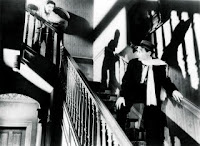Women in film noir:

LAUREN BACALL as the femme fetale in 'TO HAVE AND HAVE NOT' (1944).
 This representation could be because of the time of these films, the timeframe for them is between the 1920s and 1940s, pre war, inter war or post war, all seen as times of confusion and uncertainty, the fate of the femme fatale reassures the audience, and the victimization of the housewife makes the audience sympathise with her, all the time gaining the viewer's support for the existing societal structure as the femme fatale tries to break up the nuclear family and 'taint' the husband by having an affair with him.
This representation could be because of the time of these films, the timeframe for them is between the 1920s and 1940s, pre war, inter war or post war, all seen as times of confusion and uncertainty, the fate of the femme fatale reassures the audience, and the victimization of the housewife makes the audience sympathise with her, all the time gaining the viewer's support for the existing societal structure as the femme fatale tries to break up the nuclear family and 'taint' the husband by having an affair with him. German Expressionism:


Films that refer back to techniques of German Expressionism are set in the 1920s and 1930s and are highly stylized and full of symbolism. Described as non realistic and geometric, they include themes of dark human experiences, deceit, madness and paranoia. This originated from the migration of German filmmakers fleeing Nazi Germany/ Nazi occupied countries and moving to America during the nineteen thirties. These films are subjective to the point of view, and capture inner moods, feelings and perceptions. Extreme camera angles, like high angle/low angle shots suggest characters being watched, shadows and silhouettes are used to create suspense and distort the viewer's perception of the height of the character, for example they can be lengthened to heighten suspense, with German Expressionism "aesthetics being marked by distortions and exaggerations" (2). Other camera shots include point of view shots, which make the audience percieve the scene through one of the character's eyes, then suggesting their emotions as well as their awareness and opinion on the situation, not just through dialogue. European, and especially German influences can be seen in aspects other than the strange camera angles. The distrust of government officials and paranoia surrounding themes covered can be seen in lots, as well as the negative depiction of people in places of authority, like police officers. Much of this has obvious links to the situation and atmosphere in Europe during and prior to this period.One famous director is Fritz Lang, whose films are easily identified due to the inividualised, unique aesthetic of them. Schrader identifies this as an "uneasy, exhilarating combination of realism and Expressionism." Writing and directing in what is known as the 'Weimar period' (referring to the German Weimer Republic), Lang explored the criminal, somewhat corrupt underworld of the time and psychological conflict all under oppressive regimes, such as the one he experienced.
(1)
http://www.lib.berkeley.edu/MRC/noir/np05ff.html
(2)
http://www.let.rug.nl/usa/essays/general/does-film-noir-mirror-the-culture/the-noir-aesthetics.php
These show a sound understanding of the genre, but you need to back up your ideas with specific examples.
ReplyDelete